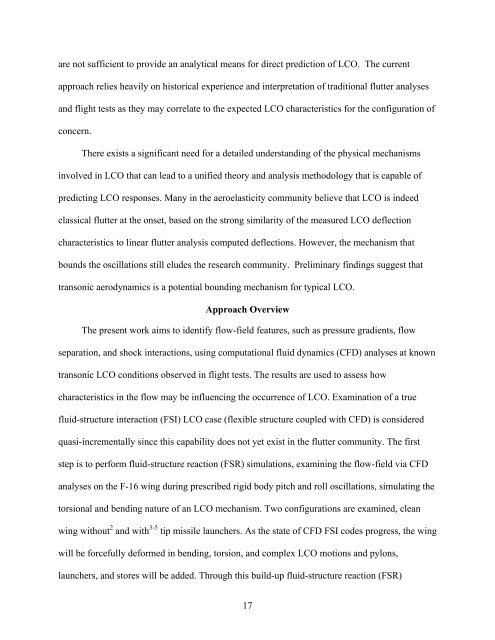university of florida thesis or dissertation formatting template
university of florida thesis or dissertation formatting template
university of florida thesis or dissertation formatting template
Create successful ePaper yourself
Turn your PDF publications into a flip-book with our unique Google optimized e-Paper software.
are not sufficient to provide an analytical means f<strong>or</strong> direct prediction <strong>of</strong> LCO. The current<br />
approach relies heavily on hist<strong>or</strong>ical experience and interpretation <strong>of</strong> traditional flutter analyses<br />
and flight tests as they may c<strong>or</strong>relate to the expected LCO characteristics f<strong>or</strong> the configuration <strong>of</strong><br />
concern.<br />
There exists a significant need f<strong>or</strong> a detailed understanding <strong>of</strong> the physical mechanisms<br />
involved in LCO that can lead to a unified the<strong>or</strong>y and analysis methodology that is capable <strong>of</strong><br />
predicting LCO responses. Many in the aeroelasticity community believe that LCO is indeed<br />
classical flutter at the onset, based on the strong similarity <strong>of</strong> the measured LCO deflection<br />
characteristics to linear flutter analysis computed deflections. However, the mechanism that<br />
bounds the oscillations still eludes the research community. Preliminary findings suggest that<br />
transonic aerodynamics is a potential bounding mechanism f<strong>or</strong> typical LCO.<br />
Approach Overview<br />
The present w<strong>or</strong>k aims to identify flow-field features, such as pressure gradients, flow<br />
separation, and shock interactions, using computational fluid dynamics (CFD) analyses at known<br />
transonic LCO conditions observed in flight tests. The results are used to assess how<br />
characteristics in the flow may be influencing the occurrence <strong>of</strong> LCO. Examination <strong>of</strong> a true<br />
fluid-structure interaction (FSI) LCO case (flexible structure coupled with CFD) is considered<br />
quasi-incrementally since this capability does not yet exist in the flutter community. The first<br />
step is to perf<strong>or</strong>m fluid-structure reaction (FSR) simulations, examining the flow-field via CFD<br />
analyses on the F-16 wing during prescribed rigid body pitch and roll oscillations, simulating the<br />
t<strong>or</strong>sional and bending nature <strong>of</strong> an LCO mechanism. Two configurations are examined, clean<br />
wing without 2 and with 3-5 tip missile launchers. As the state <strong>of</strong> CFD FSI codes progress, the wing<br />
will be f<strong>or</strong>cefully def<strong>or</strong>med in bending, t<strong>or</strong>sion, and complex LCO motions and pylons,<br />
launchers, and st<strong>or</strong>es will be added. Through this build-up fluid-structure reaction (FSR)<br />
17
















